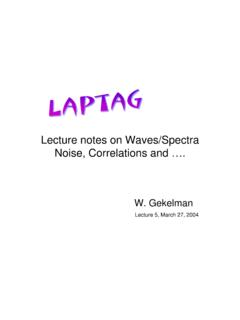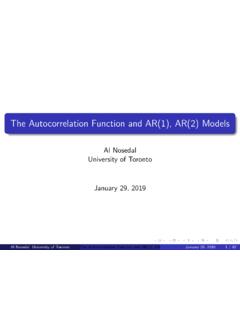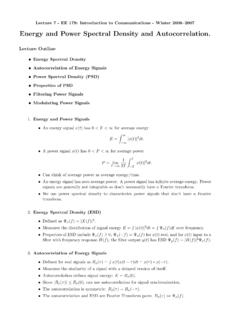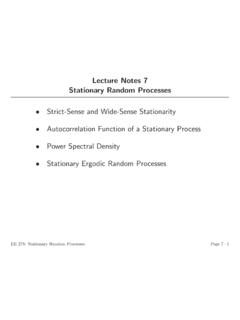Transcription of Lecture Handout Autocorrelation
1 Lecture 16. Autocorrelation In which you learn to recognise whether the residuals from your model are correlated over time, the consequences of this for OLS estimation, how to test for Autocorrelation and possible solutions to the problem 1. Given the model Yt = b0 + b1Xt + ut Think of Autocorrelation as signifying a systematic relationship between the residuals measured at different points in time This could be caused by inertia in economic variables (multiplier working through), incorrect functional form or data interpolation/revision The effect is that Cov(ut ut-1 ) 0. A simple model of this systematic relationship would be ut = ut-1 + et -1<= <=1 (1). so the current value of the residual is related to last period's value together with a current period random component et This is called an AR(1) process = Auto-regressive of order 1.
2 (a regression of the variable on itself lagged by 1 period). If =0 then residuals are not autocorrelated If >0 then residuals are positively autocorrelated (+ve residuals tend to be followed by +ve residuals and ve by ve). If <0 then residuals are negatively autocorrelated (+ve residuals tend to be followed by -ve residuals and ve by +ve). Does it matter? We know OLS estimation gives ^ Cov( X , y ) Cov( X , u ). = = +. Var ( X ) Var ( X ). but Autocorrelation does not affect the assumption that Cov(X,u)=0 so OLS remains unbiased in the presence of Autocorrelation However, can show that variance of the estimate of b in presence of Autocorrelation is ^. Cov ( X , y ) Cov ( X , u ) . Var ( autocorr OLS. ) = Var = Var +.
3 Var ( X ) Var ( X ) . u2 u2 T 1 T t =. N * Var ( X ). +2. ( N * Var ( X )) 2 . t =1 j =1. j X t X t + j = Var (bOLS noauto ) + 2 f ( ). 2. 3. where j and t are just different time periods within the period covered by the sample t = 1, 2 T time periods is the coefficient on the lag of the residual in model (1). and f( ) is some function that depends on the value of . So If 0 then can see Var(bAutocorrelated ols) Var(bolsnoauto). and if > 0. (ie positive Autocorrelation , which is the most common form of Autocorrelation ). then Var(bAutocorrelated ols) > Var(bolsnoauto). but Var(bolsnoauto)= 2u/N*Var(X) is what the computer calculates not Var(bAutocorrelated ols), so in general OLS will underestimate the true variance so the t values on the OLS estimates will be larger than should be so might conclude variables are statistically significant when they are not (type I error).
4 Testing for Autocorrelation Given time series data Yt = b0 + b1Xt + ut t = 1, 2 T (1). the model may be subject to Autocorrelation Accepted way of testing is to specify a functional form for the persistence (correlation) in the residuals over time and test to see whether this specification is statistically valid. Most common specification is as used above, namely the 1st Order Autoregressive process AR(1). ut = ut-1 + et -1<= <=1 (2). So movement in current value of residuals is related to last period's value and a current period random component (et). Good practice to test by simply plotting the residuals over time and looking at the pattern. +ve Autocorrelation means +ve residual values are followed by +ve values (and ve by ve).
5 4. 5. -ve Autocorrelation means +ve residual values are followed by -ve values (and ve by +ve). Good practice also to use the standardised residuals when do this ^. ut u s tan dardised =. s ie residuals made scale invariant by dividing through by the standard error of the equation, s = RSS / T k (scale invariance means can compare across different specifications using different units of measurement).. reg cons inc Source | SS df MS Number of obs = 58. -------------+-------------------------- ---- F( 1, 56) = Model | +12 1 +12 Prob > F = Residual | +09 56 149575459 R-squared = -------------+-------------------------- ---- Adj R-squared = Total | +12 57 +10 Root MSE = 12230. ---------------------------------------- -------------------------------------- consumption | Coef.
6 Std. Err. t P>|t| [95% Conf. Interval]. -------------+-------------------------- -------------------------------------- income | .8447215 .006479 .8317425 .8577005. _cons | ---------------------------------------- -------------------------------------- Do graphical inspection using standardised residuals ie divide residuals by standard error of regression, s, (given by Root MSE in Stata output above).. predict stanres, rstandard /* command to get standardised residuals */. two (scatter stanres year, yline(0) xlabel(1950(5)2006) ). 2 1. Standardized residuals -1 0. -2. 1950 1955 1960 1965 1970 1975 1980 1985 1990 1995 2000 2005. year 6. 7. Standardised residuals confirm general (positive) Autocorrelation pattern in residuals as before.
7 Only difference is values on y axis have changed (since are now scale invariant). However this is useful but not a formal test for the problem. One common statistical for presence of AR(1) in the residuals is to compute Durbin- Watson statistic T ^ ^. (u t u t 1 ). 2. DW = t =2. T ^ 2. ut t =1. where ut are residuals saved from from OLS estimation of (1). ^ ^. Can show that DW =2(1- ), where is taken from an OLS regression of (2) using estimated residuals from (1). ^. Given DW = 2(1- ). ^. if = 0 then DW = 2 and residuals are not autocorrelated ^. if 1 then DW 0 and +ve Autocorrelation ^. if -1 then DW 4 and -ve Autocorrelation So how close to 2 does DW have to be before we can be confident of accepting null hypothesis of no Autocorrelation ?
8 Turns out that there are 2 critical values than need to compare estimated DW against: an upper value and a lower value Reject Null. Test Accept Null Test Reject Null Accept that inconclusive inconclusive Accept there is there is (No Autocorrelation ) ve A/C. +ve A/C. 0 DWlow DWupper 2 4-DWupper 4-DWlow So if DW < DWlower conclude +ve Autocorrelation if DWupper < DW < 4-DWupper residuals are not autocorrelated if DWlower < DW < DWupper test is inconclusive 8. 9. Note: Unfortunately the critical values vary with sample size and number of RHS variables excluding the constant /* Example: DETECTION OF Autocorrelation */.. tsset year time variable: year, 1948 to 2005.. regdw cons income Source | SS df MS Number of obs = 58. -------------+------------------------------ F( 1, 56) = Model | +12 1 +12 Prob > F = Residual | +09 56 149575459 R-squared = -------------+-------------------------- ---- Adj R-squared = Total | +12 57 +10 Root MSE = 12230.
9 ---------------------------------------- -------------------------------------- consumption | Coef. Std. Err. t P>|t| [95% Conf. Interval]. -------------+-------------------------- -------------------------------------- income | .8447215 .006479 .8317425 .8577005. _cons | ---------------------------------------- -------------------------------------- Durbin-Watson Statistic = .2516256. From Tables, given T=58 and K'=1, DWlow = and DWhigh = (k'=no. rhs variables excluding the constant). So estimated value is less than DWlow. Hence reject null of no Autocorrelation . Accept there exists positive 1st order Autocorrelation . Problems with Durbin-Watson 1. The existence of an inconclusive region often reduces the usefulness of this test 2.
10 Can show DW not valid in the presence of lagged dependent variables or endogenous variables Yt = b0 + Yt-1 + b1Xt + ut (3). If there are lagged dependent variables it is possible to use Durbin's h test ^ T. h= ^. 1 TVar ( ). where T = sample size (number of time periods) and var( ) is the estimated variance of the coefficient on the lagged dependent variable from an OLS estimation of (3). Can show that under null hypothesis of no +ve Autocorrelation h ~ Normal(0,1). 10. 11. So that Pr[ <= h <= ] = ie 95% chance that value of h will lie between and + In this case if estimated h> then can reject null of no +ve Autocorrelation But: can't compute h if ^. 1 TVar ( ) < 0. which could happen So need alternative measure which can always be calculated.












